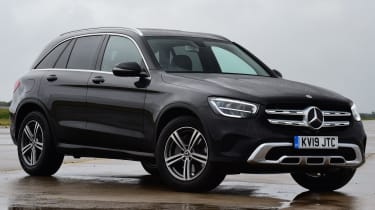Mercedes GLC SUV - MPG, running costs & CO2 (2015-2022)
The Mercedes GLC is actually quite economical given its size
The Mercedes GLC is reasonably economical for an SUV, with its claimed figures rivalling the likes of the Audi Q5 and BMW X3. Four-wheel drive comes as standard, which is why it’s not quite so frugal as some two-wheel-drive rivals. Mercedes also offers competitive warranty and servicing plans.
Mercedes GLC MPG & CO2
The 220 d version of the 2.0-litre diesel engine can return up to 46.3mpg officially, reducing slightly in top trims with optional wheels fitted. CO2 emissions of 166g/km mean it sits in the highest BiK band, which won’t appeal to company-car drivers. The more powerful GLC 300 d is a shade less economical, at up to 42.8mpg, with emissions of 173g/km. By comparison, the BMW X3 xDrive 30d offers more pace and returns 46.3mpg with 159g/km.
Petrol engines are also offered. A GLC 300 model promises up to 34mpg, while the AMG 43 and 63 models are even thirstier. They certainly prioritise speed over running costs; you can expect 26 and 22mpg respectively. All petrols are in the top BiK band.
A plug-in hybrid GLC 300 de version is now available, pairing the 2.0-litre diesel engine with a 13.5kWh battery. It offers 27 miles of electric range and up to 156.9mpg if you regularly recharge the battery, while business users will be drawn to its BiK rate; you’ll pay roughly a third of what you’d pay for the petrol and diesel cars in BiK tax thanks to its low 50g/km emissions figure.
More reviews
In 2021 it was joined by the GLC 300 e, with a 2.0-litre petrol engine and an electric range of up to 28 miles. It can officially manage up to 122.8mpg with emissions starting from 54g/km and it takes around 2.5 hours to charge the battery using a 7kW home wallbox.
Like most petrol-electric plug-in hybrids, the GLC 300 e will make the most sense to drivers who don’t often undertake long motorway journeys. As when the 300 e’s battery is depleted, you’ll see a similar fuel consumption figure to the regular petrol engines. Whereas the GLC 300 de will hold more appeal for high-mileage drivers, because you have the economical diesel engine for long trips and the electric motor for when you’re in town.
After the first year's CO2-based road tax (generally included in the on-the-road price), Mercedes GLCs cost the standard annual rate in VED (road tax), or £10 less if it's a mild-hybrid or plug-in hybrid. Every GLC now has a list price (including options) of more than £40,000, making it liable for an additional surcharge in years two to six, elevating the annual bill during that period.
Insurance
Insurance groups for the facelifted Mercedes GLC are quite high, with diesel versions starting in groups 32 and the GLC 300 de in groups 44-45 out of 50. Oddly, this is just as high as the AMG versions, in groups 41-47.
Warranty
Mercedes provides a three-year/unlimited-mileage warranty on all of its new models, which is the same as BMW offers on the X3. Pan-European Mercedes Roadside Assistance is also included, which can last up to 30 years if you keep the car maintained within the dealership network.
Servicing
Mercedes offers fixed-price servicing plans that cover all scheduled maintenance. You can pay all in one go up front or spread the cost over monthly instalments, which should be about £35 for a diesel GLC.









